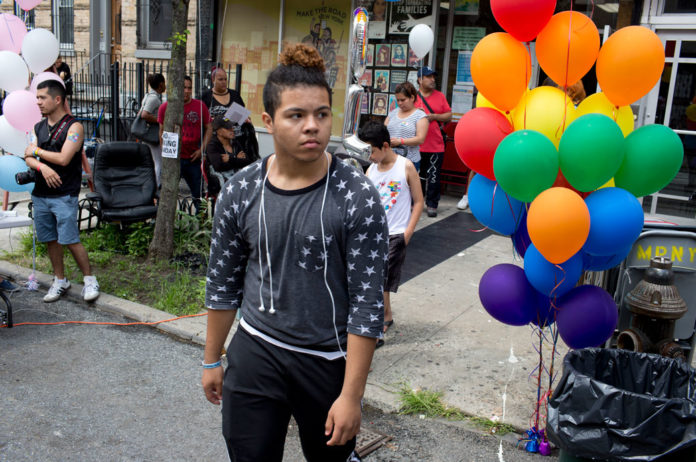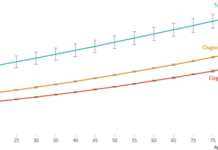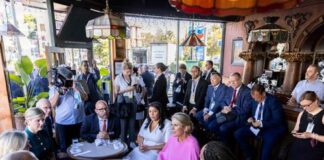
Last month’s pride celebration marked the fifth anniversary of the Pulse nightclub shooting. On June 12, 2016, a gunman opened fire on patrons of the gay club in Orlando, Florida, killing 49 people and sending shockwaves throughout the LGBTQ community across America. This anniversary is a sobering reminder of the ongoing discrimination experienced by LGBTQ individuals. But, for the Hispnic LGBTQ community, the significance takes on a separate dimension. “What happened at Pulse was … kind of labeled as a gay issue, when in reality it wasn’t,” says Joél Junior Morales, director of the LGBT+ Center, a support center for those affected by the Pulse massacre, in an interview with CNN. The vast majority of the victims were Hispanic, and assisting survivors necessitated an intersectional approach, including providing community resources in both English and Spanish; assisting family members who required visas to attend funerals; and safely supporting undocumented immigrants who were affected by the tragedy.
The Pulse shooting is one of countless instances where Hispanic and LGBTQ identities intersect to create specific needs and concerns. Recent data from the Center for American Progress* shows that Hispanic LGBTQ individuals report experiencing discrimination at a rate 15 percentage points higher than their white LGBTQ counterparts, 46 percent to 31 percent, respectively. These disparities were most evident in access to critical services, in benefits usage, in access to mental health care, and in educational settings.
Access to services
Hispanic individuals are increasingly likely to live in rural areas that are often far removed from quality health care, insurance access, and even internet connectivity. Those in urban settings are frequently located in segregated neighborhoods without access to quality and affordable food; where banks are unwilling to open branches; and where they have less access to recreational facilities. LGBTQ individuals face high rates of service denial from adoption agencies, wedding vendors, and other private businesses. They are also often discriminated against in public spaces such as restaurants. The compounding effects of residential discrimination and service denial make Hispanic LGBTQ individuals unable to access necessary services—to the point where 20 percent of Hispanic LGBTQ respondents reported that they avoided getting necessary services for themselves or their family in order to steer clear of discrimination. According to CAP’s survey:
- 36 percent of Hispanic LGBTQ individuals report that discrimination has affected their ability to obtain accurate identification documents to some degree; 25 percent of white LGBTQ respondents reported the same.
- 83 percent of Hispanic LGBTQ individuals report that finding an alternative adoption agency should they be turned away would be difficult to some degree; 74 percent of white LGBTQ respondents reported the same.
- 56 percent of Hispanic LGBTQ individuals report that finding an alternative wedding vendor should they be turned away would be difficult to some degree; 44 percent of white LGBTQ respondents reported the same.
- 33 percent of Hispanic LGBTQ individuals report that finding an alternative hotel should they be turned away would be difficult to some degree, and 32 percent report the same of finding an alternative restaurant; 20 percent and 16 percent of white LGBTQ respondents, respectively, reported the same.
Disparities in access to alternative options means that when Hispanic LGBTQ individuals are refused service, they are forced to go without hotel rooms, restaurants, wedding vendors, and even adoption agencies all together.
Economic security and benefits assistance
Hispanic individuals face significantly higher rates of poverty than their white counterparts. As a result of workforce discrimination against those perceived as immigrants; elevated levels of involuntary part-time work and underemployment; and overrepresentation in seasonal occupations, Hispanic individuals are more likely to deal with food insecurity, unemployment, and housing instability. LGBTQ individuals also face high rates of poverty, stemming from overrepresentation in service industry occupations and discrimination from financial institutions. These disparities result in high rates of benefits assistance among Hispanic LGBTQ communities:
- 32 percent of Hispanic LGBTQ individuals report receiving assistance from SNAP; 20 percent of white LGBTQ respondents reported the same.
- 25 percent of Hispanic LGBTQ individuals report receiving assistance from unemployment; 20 percent of white LGBTQ respondents reported the same.
- 17 percent of Hispanic LGBTQ individuals report receiving assistance from Pell grants or another college aid program; 10 percent of white LGBTQ respondents reported the same.
- 47 percent of Hispanic LGBTQ individuals have an income below $40,000 a year.
These factors make uniquely difficult for Hispanic LGBTQ individuals to escape cycles of poverty—and clearly show the need for targeted assistance to combat the compounded effects of discrimination.
Mental health and barriers to care
A compendium of literature shows that Hispanic individuals have less access to quality and affordable mental health care services than their white counterparts. High rates of uninsurance and a lack of bilingual mental health care providers—as well as few counselors with an understanding of the unique struggles within Hispanic communities—all contribute to these disparities. Furthermore, there are significantly fewer pharmacies in predominantly Hispanic neighborhoods, contributing to the fact that Hispanic youth are far less likely to use antidepressants and necessary ADHD medication. For LGBTQ individuals, high rates of discrimination often lead to poor mental health, resulting in high rates of anxiety, self-harm, and suicidal ideation. CAP data reflects these impacts:
- 62 percent of Hispanic LGBTQ individuals report feeling so sad that nothing could cheer them up to some degree; 53 percent of white LGBTQ respondents reported the same.
- 71 percent of Hispanic LGBTQ individuals report feeling restless or fidgety to some degree; 65 percent of white LGBTQ respondents reported the same.
- 54 percent of Hispanic LGBTQ individuals report that finding an alternative doctor’s office should they be turned away would be difficult to some degree, and 34 percent report the same of finding an alternative pharmacy; 47 percent and 21 percent of white LGBTQ respondents, respectively, reported the same.
- 33 percent of Hispanic LGBTQ people reported some form of negative or discriminatory treatment from a doctor or health care provider in the year prior; 17 percent of white LGBTQ respondents reported the same.
- 22 percent of Hispanic LGBTQ people had to teach their doctor about their sexual orientation to get appropriate care; 8 percent of white LGBTQ respondents reported the same.
- 11 percent of Hispanic LGBTQ people had a doctor refuse to see them because of their sexual orientation, and 22 percent had a doctor who was visibly uncomfortable due to their sexual orientation; 4 percent and 11 percent of white LGBTQ respondents, respectively, reported the same.
Mental health concerns are exacerbated by lack of access to quality care, placing Hispanic LGBTQ individuals at unique risk.
Workplace and educational settings
Hispanic students face unique challenges in our school system, and many experience bullying and harassment because of their race or ethnicity. Beyond mistreatment from their peers, Hispanic students are also significantly more likely to face in-school discipline—impacting their ability to succeed in the classroom—and are more likely to face suspension and expulsion for minor offenses. LGBTQ students regularly report harassment and discrimination at school and often encounter harmful policies that prevent them from using the bathroom of their gender; bringing a same-sex partner to a school function; or even wearing certain clothing. In the workforce, Hispanic individuals encounter discriminatory hiring practices and regular microaggressions in the workplace, which can be compounded by the microaggressions and hiring discrimination faced by LGBTQ individuals. These concerns are clearly visible in CAP’s survey results:
- 25 percent of Hispanic LGBTQ individuals reported making specific decisions about where to go to school in order to avoid discrimination; 19 percent of white LGBTQ respondents reported the same.
- 18 percent of Hispanic LGBTQ individuals have no high school diploma; 9 percent of white respondents reported the same. Meanwhile, 36 percent of white LGBTQ respondents have a college degree, while 27 percent of Hispanic LGBTQ individuals reported the same.
- 52 percent of Hispanic LGBTQ individuals reported that discrimination negatively affected their ability to be hired to some degree, while 54 percent reported that it negatively impacted their salary or ability to be promoted to some degree.
Discrimination in these settings is particularly harmful as it directly prevents Hispanic LGBTQ individuals from achieving economic stability, exacerbating the impacts of limited service access and employment opportunities.
Housing
When searching for housing, Hispanic individuals are often forced to deal with landlords, lenders, and real estate agents who engage in discriminatory practices, heightening residential segregation and keeping Hispanic homeownership rates much lower than that of white individuals. LGBTQ individuals face similar concerns, struggling with discrimination from real estate agents and when requesting loans, leading to homeownership rates far below the national average. According to CAP data:
- 43 percent of Hispanic LGBTQ people report that discrimination has affected their ability to rent or purchase a home to some degree; 32 percent of white LGBTQ respondents reported the same.
- 29 percent of Hispanic LGBTQ people report experiencing discrimination in an apartment community; 14 percent of white LGBTQ respondents reported the same.
- 12 percent of Hispanic LGBTQ individuals report receiving assistance from the Low-Income Home Energy Assistance Program (LHEAP); 7 percent of white LGBTQ respondents reported the same.
Access to stable housing is an essential element of mental and physical health, encompassing everything from the availability of clean water to proper storage of medications. Significant disparities for Hispanic LGBTQ individuals compound the impacts of discrimination and lack of access to quality health care.
Conclusion
The Hispanic LGBTQ community encounters compounding levels of discrimination. Because of its unique composition, this community requires targeted assistance. As a result of residential segregation combined with discrimination from businesses, Hispanic LGBTQ individuals face high rates of service denial and often lack access to alternative services. Language barriers and lack of culturally competent care contribute to large-scale mental health concerns. And discriminatory school policies make it difficult for Hispanic LGBTQ individuals to access a quality education. In order to effectively combat discrimination, lawmakers must consider the specific needs of Hispanic LGBTQ Americans.
Lindsay Mahowald is a research assistant with the LGBTQ Research and Communications Project at the Center for American Progress.
*Data throughout this column are from a nationally representative survey of 1,528 LGBTQ+-identifying individuals, jointly conducted in June 2020 by the Center for American Progress and NORC at the University of Chicago, which has been weighted to account for both U.S. population characteristics and survey nonresponse. Unless otherwise indicated, all comparisons between white respondents and Hispanic respondents are significant at the 0.05 level.








